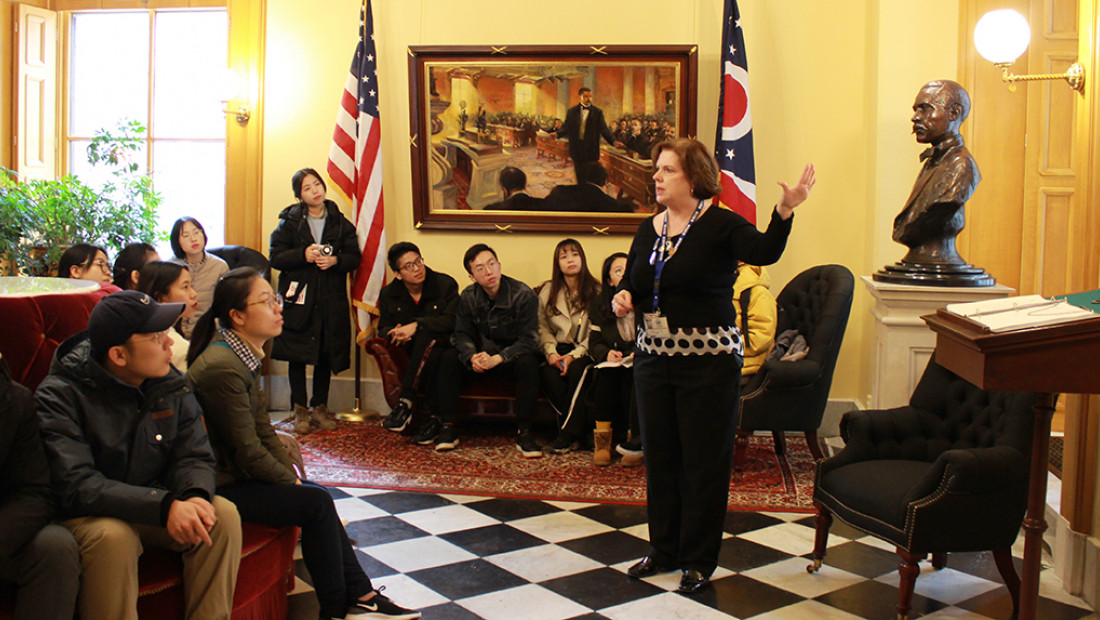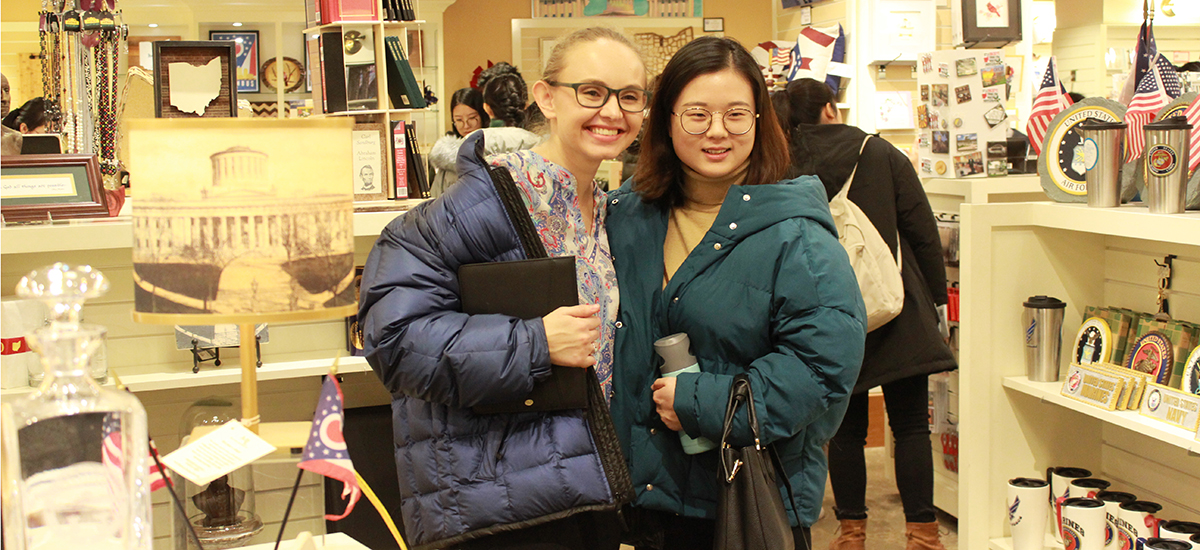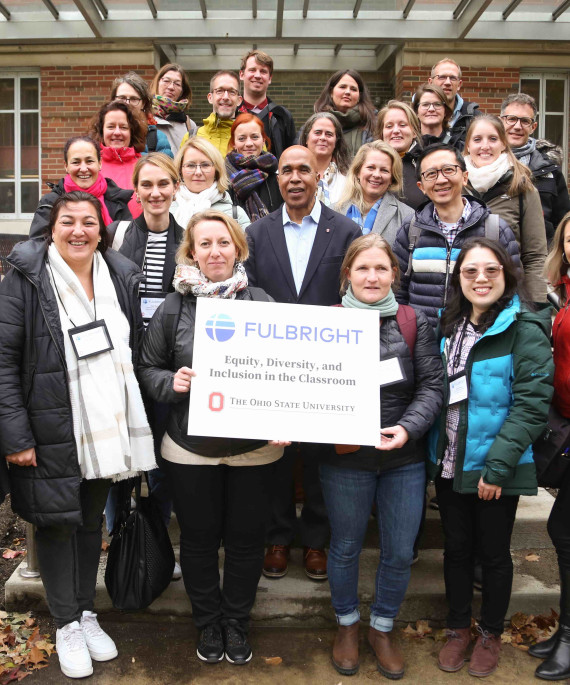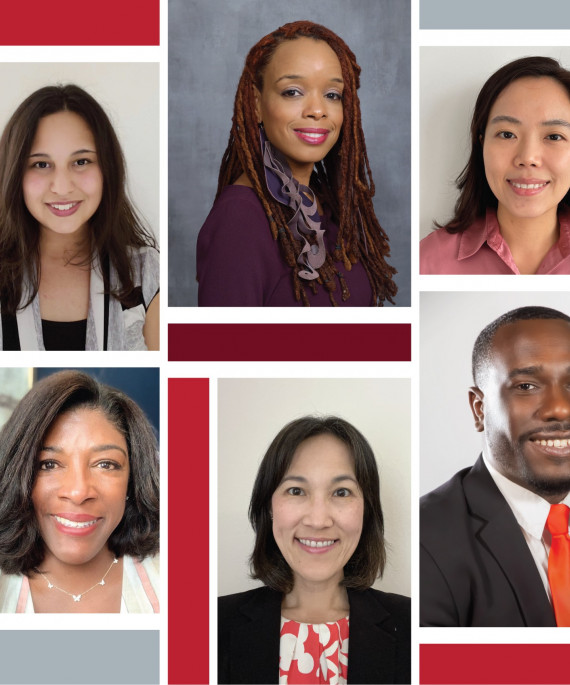
Students from Zhejiang Normal University listen to a docent at the Ohio State House as part of their cultural training at The Ohio State University.
Zhejiang Normal University students come to learn language, culture, research methods
When a delegation of 26 Chinese students arrived at the Columbus airport in December, not many were talking — at least not in English. (It was a long flight.)
The students had come from Zhejiang Normal University as a part of an international grant awarded to Ohio State’s College of Education and Human Ecology. The goal: Train the STEM education students in research methodologies, English language and American culture.
But during those first days, the students were hesitant.
In their onboarding essays, “They told us they’re shy, they’re not confident, they’re afraid to speak English,” said Ivan Stefano, director of the college’s Workplace and Professional English Program and co-director of the exchange.
By the time they met the college’s new dean, the students’ insecurity had vanished. Enthused by his presence and his “eloquence,” they peppered Don Pope-Davis with questions.
How long had he been at Ohio State? (Only since July.) What did he do in his spare time? (Watch Netflix, read books, enjoy some rare peace and quiet.) Was he going to visit their university in China? (He really hoped so.) The students treated the dean like a rock star.
“And this was less than two weeks after they came,” Stefano said. “They were already in their element. It was amazing.”
The students’ 12-week schedule is power-packed with classes about quantitative research, field observations to demonstrate qualitative research, training in English. It includes visits to local schools, cultural excursions to the zoo, the Ohio State House and the conservatory and shopping in the Short North and at a suburban mall. (They’ve become unabashed shopaholics, student Qianlun Shi said.)
All instruction is in English. Every outing is a cultural lesson and a practicum for language learning. Buying lipstick or talking to a museum docent, after all, reinforces everyday dialogue, so critical to language fluency.
An interdisciplinary, cross-departmental effort
The $250,000 grant project has become a multi-unit collaboration within the college, said Lin Ding, associate professor of science education and co-director for the project. The STEM Education Program, the American Language Program and the Center on Education and Training for Employment all have coordinated instruction.
“Every session is taught by an instructor from a different research team,” Ding said. “This really deploys our resources from different units. Dean Pope-Davis talks about working cohesively, toward the same direction. We are a big, happy family, and I think this program really unites everybody.”
And the cultural exchange is not one-sided. College staff, student assistants and student workers attend classes and serve as guest speakers.
“I want my student workers, for example, to be involved because our Chinese students want to talk to other students,” Stefano said.
The Center on Education and Training for Employment has “adopted” the students, sharing expertise about how they develop tests for workforce development and career education. The students’ enthusiasm is contagious, said Traci Lepicki, associate director of the center.
“They get to see the center in action,” she said. “We give them a ‘lab experience’ where they can learn about educational topics that we work with and see us implement them.”
Center director Ana-Paula Correia met students afterhours to talk about online education, her area of expertise. “It was a vibrant discussion with much to share and learn.”
Securing the grant was part of a concerted effort by the college to foster collaboration and increase college engagement at the global level.
“We’re taking a real systems approach to developing enduring, meaningful relationships that align with our mission and values as a college — multi-culturalism, inclusivity and equity,” said Kerry Dixon, executive director for civic and global engagement for the college. “These values are true north for us, and they need to be centralized when we’re thinking about global engagement.”
The program provides a strong foundation for strengthening the college’s ties to Zhejiang Normal University, a top teaching institution not only in Zhejiang Province but also in China, Dixon said.

Finding common, and uncommon, ground
Charged by their instructors to interview their American counterparts, the Chinese students have been surprised at their commonalities.
“We ask what is the most important thing in their life,” said Piaosa Zhang, a master’s student and group leader. She expected them to say American freedom or its signature self-reliance.
Instead, “we find that family is the most important,” she said. “It’s the same in China.”
Both Americans and Chinese exchange ideas. “We learn a lot from the students, about their culture, about their country, about how they do things, comparisons between educational systems,” Stefano said.
Some differences are stark, the Zhejiang students said.
“The relationship between teachers and students is more equal in America,” Xulu Jiang said. When a Chinese instructor teaches, she said, students wait until after class to ask questions.
Mandy Smith, assistant professor of science education, knew her teaching style would be very different culturally from what Chinese students are used to. A collaborator on the project, she considered how to teach qualitative research methods to the group. “I really had to think about if I was going to change my pedagogical approach.”
She decided to teach the course much like she would teach in a K-12 school, informed by her research about the nature of inquiry, socially constructed cognition and themes of justice and equity through STEM education. She wanted to maintain her pedagogical style, teaching by modeling, but also stay open to learning from them.
“About halfway through my first class, they told me that they’ve never talked so much in a collegiate course,” Smith said. “They were used to listening.”
“You’re getting a full immersion into the cultural experience of a class at Ohio State,” she told the class.
“That’s been a running theme throughout,” she said.
The Zhejiang Normal University students — many of whom will become teachers or instructors themselves — are intrigued to the point of reimagining their own teaching practice.
“In America, teachers always ask, ‘Do you have any questions?’” Jiang said. “I think that’s a very good question.”




